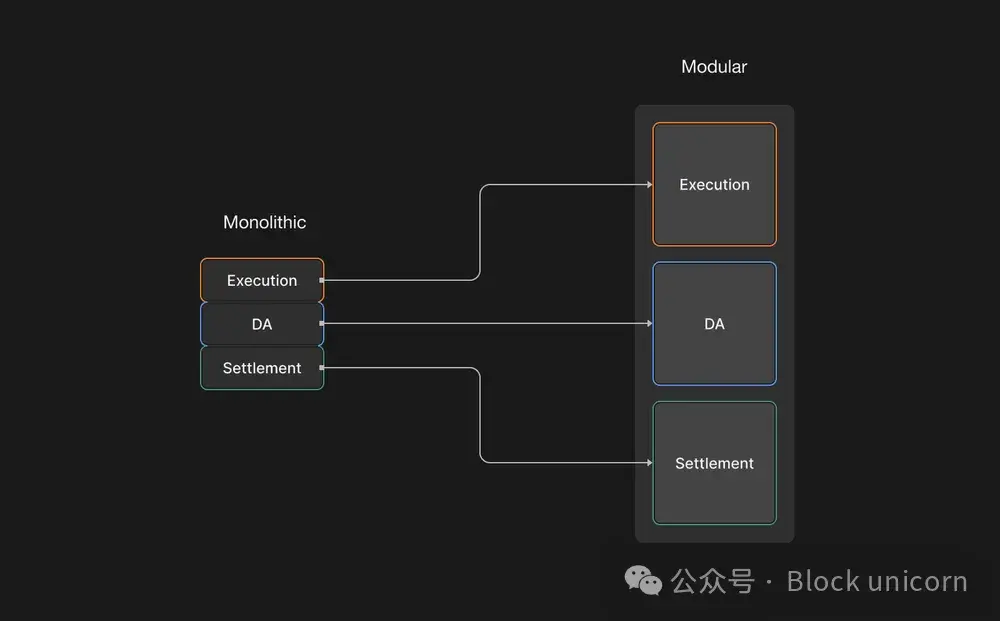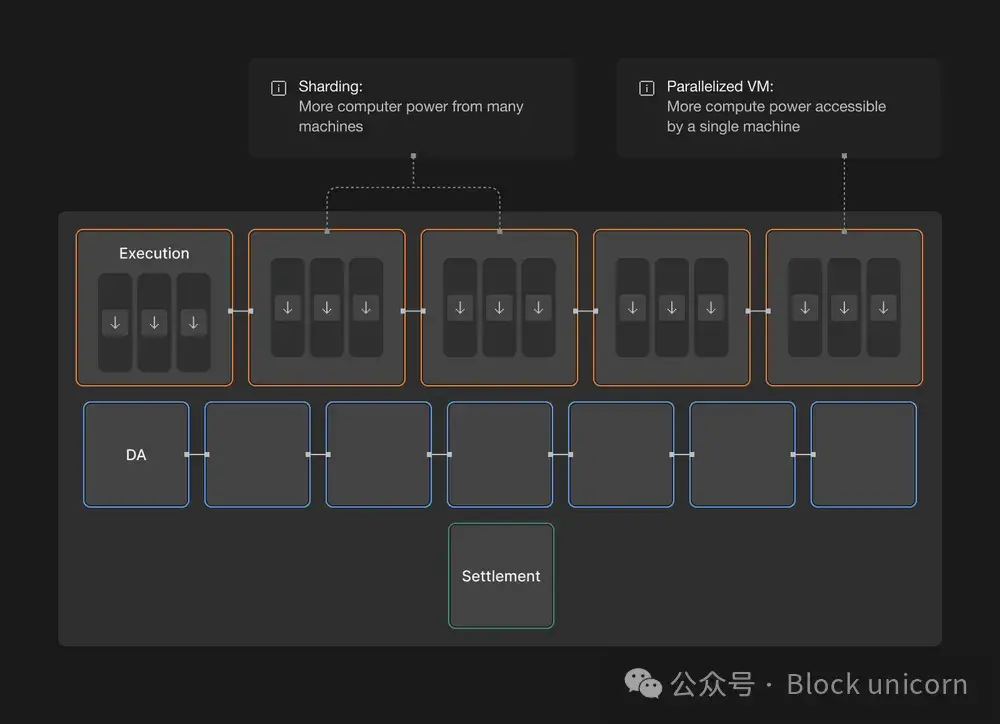Modularity vs. Monolithic architecture is dead
Since the rise of Rollups, the expansion of blockchain has been focused on the debate between modularity and monolithization. Initially, this binary opposition was a useful mental model for reasoning about blockchain scalability, but now, these two The camps have all moved beyond it. Today, the contrast between modularity and
monolithicbrings unnecessary restrictions to our scalability mental model. So,
orare there any alternatives? In this article, we
willshow how horizontal scaling versus vertical scalinghas always been the ## of blockchain scalability #Basic framework, And explain how adopting horizontal expansion and vertical can lead to better expansion solutions. Understanding modularity vs. monolithic
First, some definitions:
Modular
The chain separatesthe core functionality of the blockchain into different layers. Monolithization
Chain integrates all core functionality into a single, interconnected layer.We can think of "layers" as "machines" - Monolithic The chain has a
singlevalidator node that runs all tasks, while The modular chain has multiple (2-3) full nodes running different tasks.

For example, Rollup typically has two running nodes: a Rollup full node for execution, and one for Settlement Data Availability (DA) for Ethereum full nodes. Validium may use three running nodes: a Rollup full node for execution, an Ethereum full node for settlement, and one for DA Standby data availability tier full node.
Modular allocation of blockchain tasks to at least two full nodes. By doing this, modular blockchains can leverage the computing power of multiple computers when constructing each block.
This is a form of horizontal expansion.
Modularity is useful when thinking about blockchain scalability because it is a type of horizontal scaling.

single camp chooses Scale through software optimizations, implementation of parallel virtual machines, data pipelines, faster network protocols, and (most notably) more powerful hardware. Essentially, a monolithic chain attempts to extract as much computing power as possible from a single full node. This is a form of
vertical expansion. Critics
believethat this approach tends to be centralized: if you rely on increasing the power of a single node to scale, you will inevitably encounter the limitations of the underlying hardware. Physical limitations and forcing increased hardware requirements to scale further. However, this criticism is
incorrect, because not all singleization chains rely solely on vertical scaling.
For example, Near is a monolithicL1 blockchain built on a sharded network architecture. This means that Near's full nodes are responsible for all tasks (i.e. execution, settlement, and data availability), but they are only responsible for a small portion of Near's global state. Therefore, Near leverages the computing power of multiple computers (just like a modular chain) by allocating work based on status rather than task .
 We can see that
We can see that
is a single chain Still modular chains, have no restrictions in terms of the extension technologies they implement. Both can be expanded horizontally and/or vertically. In addition, the debate between modularity and monolithization is always rooted in the framework of horizontal and vertical expansion. From a strictly technical perspective, modular
tends tohorizontally expand, which is inherent in its design, while monolithic ##Tend to vertical expansion.
Now that we have successfully launched the modular chain, the additional expansion advantage is no longer "more modular". The focus now is on how the chain can utilize horizontal or vertical scaling techniques.
Adopting a horizontal vs. vertical thinking model allows us to easily reason about what each chain is doing in the process trade off.
Redefining the Conversation: Horizontal vs. Vertical Scaling
Before delving into the horizontal vs.vertical scaling framework, it’s important to acknowledge that its origins date back to the 20th century In the 1970s, distributed computing research laid the foundation for the concept of horizontal scaling. Today, all scaling technologies can be classified as horizontal or vertical scaling.
Vertical expansion
Vertical expansion will increase the hardware utilization of each node or Hardware requirements. In blockchain, this is usually done through software optimizations such as parallel virtual machines (i.e. multi-threaded processes).
A common example is EVM and SVM.
EVM executes transactions in order, while SVM executes transactions in parallel. SVM achieves this by utilizing more CPU cores, so SVM can handle more transactions per second than EVM. NOTE: This type of vertical extension is the foundation behind Eclipse L2.
In terms of trade-offs, vertical scaling is limited by available hardware, tends to be centralized due to increased hardware requirements, and is less scalable than horizontal scaling.

Horizontal expansion
On the other hand, Horizontal expansion Increase the number of machines the system can access by spreading the workload across multiple nodes. As mentioned before, modular chaining essentially distributes tasks across multiple machines. However, chains can often achieve a greater degree of horizontal scaling through sharding.

=nil;A useful example is provided here.
In November last year, the =nil; foundation launched a verifiable sharding architecture called zkSharding, which is the new Ethereum The basis of Fang L2. =nil; The core of the design is to divide its global state into multiple shards. Each shard is run by a =nil; decentralized committee, which builds blocks and manages cross-shard transactions . Additionally, each shard generates a validity proof that is sent to the master shard for aggregation and then published and verified on Ethereum. =nil; Take advantage of the ability of horizontal scaling in two ways:
- First, =nil; is a A modular blockchain that leverages Ethereum's strong consensus and data availability as guarantees to distribute tasks
across multiple full nodes.
- Secondly,
, =nil; is a sharded blockchain, so part of the state is distributed across many full nodes.
Both techniques reduce the load that any single machine needs to bear and
overall scalability of the network. So,
What are the trade-offs for horizontalexpansion? This comes down to two things: network and consensus complexity and asynchronous communication between machines or shards. The Endgame of Ethereum Scalability
Neither Horizontal Scaling nor Vertical ScalingBureau Limited to Modular or Monolithic ized architecture. This is why the horizontalvs.vertical scaling framework provides more space to explore new solutions and make modular blockchains more scalable.
For example, one option is to vertically extend one layer of the modular stack. A commonly method is to implement parallel virtual machines to improve execution throughput. As mentioned above, Eclipse is leveraging SVM and other Rollups, such asStarknet, implement BlockSTM for parallelization.
However, vertical expansion is always limited by the limitations of a single machine, and we cannot break the laws of physics.
One solution might be to opt for horizontal scaling via sharding .
Current modular designs are just beginning to touch the full potential of horizontal scaling. With sharding, we can leverage the computing power of any number of machines (rather than just 2-3 machines sharing tasks).
In other words, many machines can run the same type of tasks in parallel. This is what Ethereum and Celestia hope to achieve through Danksharding and data sharding respectively. However, sharding is not inherently limited to the data availability layer - it can also be combined with execution (as in the case of =nil; L2). If we combine the horizontal scaling achieved through the modular stack with the horizontal scaling provided by sharding, we will Get a massive increase in available computing power
. 
The ultimate goal of blockchain scalability will be convergence
Scale horizontally and vertically, resulting in a sharded blockchain with parallel virtual machines.
At the =nil;
Foundation, we are systematically designing toward this end state Moving forward .  =nil
=nil
L2 takes by leveraging a modular, horizontally scalable architecture (zkSharding) and vertically scalable validator implementation (intra-shard parallelization) An aggressive expansion roadmap. Thus, =nil;’s design enables global scale without sacrificing state, liquidity, or user fragmentation.
#If you are curious about horizontal scaling and zkSharding, you can join the conversation on the =nil; Foundation’s Discord and X.
The above is the detailed content of Modularity vs. Monolithic architecture is dead. For more information, please follow other related articles on the PHP Chinese website!

Hot AI Tools

Undresser.AI Undress
AI-powered app for creating realistic nude photos

AI Clothes Remover
Online AI tool for removing clothes from photos.

Undress AI Tool
Undress images for free

Clothoff.io
AI clothes remover

Video Face Swap
Swap faces in any video effortlessly with our completely free AI face swap tool!

Hot Article

Hot Tools

Notepad++7.3.1
Easy-to-use and free code editor

SublimeText3 Chinese version
Chinese version, very easy to use

Zend Studio 13.0.1
Powerful PHP integrated development environment

Dreamweaver CS6
Visual web development tools

SublimeText3 Mac version
God-level code editing software (SublimeText3)

Hot Topics
 1393
1393
 52
52
 1205
1205
 24
24
 Recommended essential software for currency contract parties
Apr 21, 2025 pm 11:21 PM
Recommended essential software for currency contract parties
Apr 21, 2025 pm 11:21 PM
The top ten cryptocurrency contract exchange platforms in 2025 are: 1. Binance Futures, 2. OKX Futures, 3. Gate.io, 4. Huobi Futures, 5. BitMEX, 6. Bybit, 7. Deribit, 8. Bitfinex, 9. CoinFLEX, 10. Phemex, these platforms are widely recognized for their high liquidity, diversified trading functions and strict security measures.
 What does cross-chain transaction mean? What are the cross-chain transactions?
Apr 21, 2025 pm 11:39 PM
What does cross-chain transaction mean? What are the cross-chain transactions?
Apr 21, 2025 pm 11:39 PM
Exchanges that support cross-chain transactions: 1. Binance, 2. Uniswap, 3. SushiSwap, 4. Curve Finance, 5. Thorchain, 6. 1inch Exchange, 7. DLN Trade, these platforms support multi-chain asset transactions through various technologies.
 What is a quantum chain? What are the quantum chain transactions?
Apr 21, 2025 pm 11:51 PM
What is a quantum chain? What are the quantum chain transactions?
Apr 21, 2025 pm 11:51 PM
Quantum Chain (Qtum) is an open source decentralized smart contract platform and value transmission protocol. 1. Technical features: BIP-compatible POS smart contract platform, combining the advantages of Bitcoin and Ethereum, introduces off-chain factors and enhances the flexibility of consensus mechanisms. 2. Design principle: realize on-chain and off-chain data interaction through main control contracts, be compatible with different blockchain technologies, flexible consensus mechanisms, and consider industry compliance. 3. Team and Development: An international team led by Shuai Chu, 80% of the quantum coins are used in the community, and 20% rewards the team and investors. Quantum chains are traded on Binance, Gate.io, OKX, Bithumb and Matcha exchanges.
 How to trade quantum chains
Apr 21, 2025 pm 11:42 PM
How to trade quantum chains
Apr 21, 2025 pm 11:42 PM
The quantum chain (Qtum) transaction process includes three stages: preliminary preparation, purchase and sale. 1. Preparation: Select a compliant exchange, register an account, perform identity verification, and set up a wallet. 2. Purchase quantum chains: recharge funds, find trading pairs, place orders (market orders or limit orders), and confirm transactions. 3. Sell quantum chains: Enter the trading page, select the trading pair and order type (market order or limit order), confirm the transaction and withdraw cash.
 What are the hybrid blockchain trading platforms?
Apr 21, 2025 pm 11:36 PM
What are the hybrid blockchain trading platforms?
Apr 21, 2025 pm 11:36 PM
Suggestions for choosing a cryptocurrency exchange: 1. For liquidity requirements, priority is Binance, Gate.io or OKX, because of its order depth and strong volatility resistance. 2. Compliance and security, Coinbase, Kraken and Gemini have strict regulatory endorsement. 3. Innovative functions, KuCoin's soft staking and Bybit's derivative design are suitable for advanced users.
 Recommend several apps to buy mainstream coins in 2025 latest release
Apr 21, 2025 pm 11:54 PM
Recommend several apps to buy mainstream coins in 2025 latest release
Apr 21, 2025 pm 11:54 PM
APP software that can purchase mainstream coins includes: 1. Binance, the world's leading, large transaction volume and fast speed; 2. OKX, innovative products, low fees, high security; 3. Gate.io, a variety of assets and trading options, focusing on security; 4. Huobi (HTX), low fees, good user experience; 5. Coinbase, suitable for novices, high security; 6. Kraken, safe and compliant, providing a variety of services; 7. KuCoin, low fees, suitable for professional traders; 8. Gemini, emphasizes compliance, and provides custodial services; 9. Crypto.com, providing a variety of offers and services; 10. Bitstamp, an old exchange, strong liquidity,
 Quantum Chain Exchange Ranking Top 10 Recommended (Updated in 2025)
Apr 21, 2025 pm 11:48 PM
Quantum Chain Exchange Ranking Top 10 Recommended (Updated in 2025)
Apr 21, 2025 pm 11:48 PM
Quantum chains can be traded on the following exchanges: 1. Binance: One of the world's largest exchanges, with large trading volume, rich currency and high security. 2. Sesame Open Door (Gate.io): a large exchange, providing a variety of digital currency transactions, with good trading depth. 3. Ouyi (OKX): operated by OK Group, with strong comprehensive strength, large transaction volume, and complete safety measures. 4. Bitget: Fast development, provides quantum chain transactions, and improves security. 5. Bithumb: operated in Japan, supports transactions of multiple mainstream virtual currencies, and is safe and reliable. 6. Matcha Exchange: a well-known exchange with a friendly interface and supports quantum chain trading. 7. Huobi: a large exchange that provides quantum chain trading,
 The latest updates to the oldest virtual currency rankings
Apr 22, 2025 am 07:18 AM
The latest updates to the oldest virtual currency rankings
Apr 22, 2025 am 07:18 AM
The ranking of virtual currencies’ “oldest” is as follows: 1. Bitcoin (BTC), issued on January 3, 2009, is the first decentralized digital currency. 2. Litecoin (LTC), released on October 7, 2011, is known as the "lightweight version of Bitcoin". 3. Ripple (XRP), issued in 2011, is designed for cross-border payments. 4. Dogecoin (DOGE), issued on December 6, 2013, is a "meme coin" based on the Litecoin code. 5. Ethereum (ETH), released on July 30, 2015, is the first platform to support smart contracts. 6. Tether (USDT), issued in 2014, is the first stablecoin to be anchored to the US dollar 1:1. 7. ADA,



